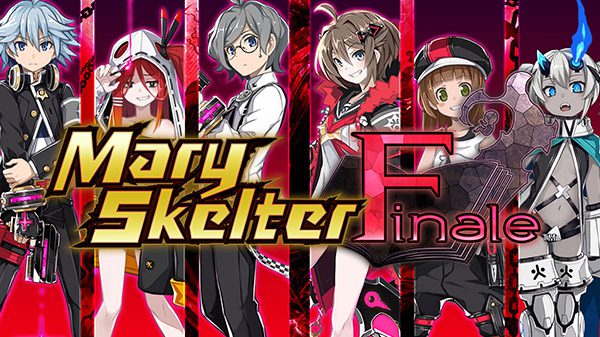The Mary Skelter series is a bit of a weird one, but it’s pretty fun. It’s one of those first-person grid-based dungeon-crawling RPGs, but with JRPG combat. There’s a lot of these series recently, and most of them are pretty good. Mary Skelter separates itself a bit with the heavy amount of puzzles/traps in the dungeons, as well as the stalking nightmares.
This is the last game in the series, at least following the current plotline, so I wanted to play it but had a bunch of other stuff to play back when it came out, so it took a backseat. And finally, I’ve played it.
So let’s go and review this thing!
Developer: Idea Factory
Publisher: Compile Heart
Release date: September 30th 2021
Platforms: Switch, PS4 (Switch version played)
Genre: Dungeon-crawler RPG
Review
The plot is a bit of a mess because of the nature of the series after 2. Specifically, Mary Skelter 2 is an alternate timeline that merges into 1 and changes the ending of 1. This is why Mary Skelter 2 actually includes the first game, creating a new canon ending to the first game. But now Finale continues after that new canon ending. After making it through the Jail Tower, Jack and the Blood Maidens, alongside a big bunch of people who lived underground with the group, are making it up to the world’s surface, to freedom. However, what they find isn’t the freedom they hoped for. Instead, they get ambushed by a group called Genocide Pink (which the translators randomly decided to change to “Massacre Pink” for whatever reason), grey-skinned girls with weird weapons (with blue glowy bits) and names based on execution devices (Guillotine, Gallows, Iron Maiden and Pyre). The group also notices a massive Jail Tower nearby, and piles of freshly-killed corpses. Genocide Pink members start killing the group almost indiscriminately (with orders not to kill Alice), and even the Blood Maidens are no match. In the chaos, Hikari is wounded but manages to teleport everyone to a “safe” destination, that being nearby Jail Towers infested with Marchens and Nightmares. But, due to her wound, she has little control, so everyone is separated, some to different Jail Towers.
At first, you’re split up into 6 groups, but after the first chapter you end up with 3 groups, each with one “leader” using a Mary Gun and 5 Blood Maidens. Jack’s group, Clara’s group (who gets Blood Youth powers from a blood transfusion), and Red Riding Hood’s group (with an amnesiac as the “leader”, who they name Toh). There’s a fourth group that is kinda hardly important. Clara’s group ends up teaming up with Pyre, one of the Genocide Pink who seems unwilling to kill (unlike the rest who are too happy too). Toh is an amnesiac but agrees to help the group through the towers for his own ends (IE finding his. And Jack’s group is doing the usual, they’re kinda used to this stuff. Each group is working through Jail Towers, where they end up finding orbs that bring them to different ones. Progress through the towers is happening simultaneously between the 3 groups, and there’s a lot of pulling switches with one group opening doors up for the other groups, so, without knowing until the end, they’re helping each other. All groups decide that the best course of action is to destroy the Devouring Armada Tower (based on different information they gather through the different towers they’re traveling through). The Devouring Armada Tower is the one they saw in the distance after getting to the surface. It flies, moves fast, and, as the name implies, devours everything in its path, living or not.
So that’s it without getting into spoiler territory. There’s lots of optional stuff (which is good if you want character development, because the main story has very little of that for most characters other than Toh, Mary, and Pyre), a bunch of new characters (including 2 pretty interesting new Blood Maidens, including the crazy overpowered Mary who is based off the Little Match Girl and has powers related to that story), and it’s all pretty fucking funky due to one of the big plot twists late in the story. And also the aliens and amnesia and stuff. Overall not a bad story, but they could cut some of it out. There are lots of repeating things as characters in different groups learn them, and the optional stuff gets super lengthy (so I end up just skipping it). It could certainly learn brevity, in any case.
So the gameplay… Well, not much has changed since Mary Skelter 2, or that version of 1. It’s still a first-person, grid-based, dungeon-crawling JRPG. So you more around in a grid, seeing around 5 spaces in front of you. There’s all sorts of spots in dungeons, from hearts that increase the dungeon’s libido meter, item pickups (randomized drops based on the dungeon), chests (those give a set thing per chest), doors, switches and traps. Traps can be simple holes that you just have to not walk into, some may be spikes or guillotines that periodically activate, there’s a few spots where arrows shoot from walls, and sliding floors for some of the simplest sliding floor puzzles I’ve ever seen. Each Blood Maiden has a power (sometimes vaguely based on the fairy tale they’re named after) that can be used in dungeons. Some shoot arrows to press switches, Rapunzel has hair she can use to… grab on to ziplines? I don’t get it… Some can make you run fast. Alice can place a rabbit hole (which is just a fairly useless save point). Place giant balls in baskets or on top of switches… and a couple more. Some have use for puzzles, like Hameln’s magnetic power to move blocks or change switches from a distance. I feel for the most part that the “puzzles” are a bit too easy.
The dungeons themselves are massive labyrinths. Each floor is split into 3 sections, one for each group to go through (and a few of these dungeons beg the question as to why they don’t see each other because some of them have windows to the other sections, literally). There’s lots of winding corridors, shortcuts to different parts of the section (usually there’s a quick way to go from one floor to another once you’re done with a floor, that way going back from the base to your current floor is pretty quick (there’s some dungeons where that’s less ideal, one of them you can’t even auto-pilot from one end to the other). These dungeons are always a bit simple, but they’re fine by me. And in Mary Skelter they’re always really weird-looking. Like one’s background visuals is a theme park, but it’s covered in torture devices. It’s all pretty random.
So how you progress is by going through these dungeons. When you’ve covered the entire map and can no longer progress, usually because of a locked door, it’s time to “zap” to a different character group. Bumping into a locked door will tell you if it’s just locked, if it’s locked from behind (in which case it’s likely just a shortcut) or if it requires a key. Zapping just means switching to a different party. So you continue with one of the other 2 parties to try and find a key or switch that may open a door in another party’s dungeon. There’s always an order to things. There’s a part of Toh’s dungeon you can only get if you push 3 buttons in Jack’s dungeon, though that’s the only time something like that happens with buttons in the game so I got a bit paused by that. It’s fun progression.
I actually don’t have TOO much to talk about combat-wise, as it’s fairly straightforward. Characters can be places in front or back row (with the usual defense and attack changes based on position, unless you get a ranged weapon which means you don’t get a penalty from being in the back row). Turn order happens based on the Agility stat. On a character’s turn they’ll get a few options: Attack, Skill, Lick, Defend and Escape. The party leader gets a few different options: Reload, Mary Gun, Item, Protect and Escape. Attacks have a different range. Either single target, all targets, horizontal line, vertical line and a “set range” which is a circle that will hit any character that fit in that circle (so you can hit all targets if your circle range is big enough). Enemies have weaknesses and strengths to certain elements, and of course defense (there’s basically one enemy in the game where this really matters, who won’t get hurt by physical attacks). All this is as you’d expect from any JRPG.
But there’s a few quirks to the combat, or maybe you didn’t notice the “Lick” option earlier. Crits make enemies bleed, and the blood splatters on your characters. This fills up a blood meter, and when it’s full at the start of their turn, they’ll go into Massacre mode, which increases their stats but also unlocks Massacre attacks (which are extremely strong and frequently target multiple enemies, you get them by progressing each character’s affection events). Massacre lasts a turn or 2, but it’s very useful. The blood meter has 2 other uses. The first one is the Lick option. This allows one girl to lick the splattered blood off another girl’s body. This provides various benefits, depending on who is getting licked. Some characters provide party benefits, while others provide benefits only to the character doing the licking. These benefits can be a shield that protects from a few attacks, healing, SP recovery and some stat upgrades (usually accuracy and evasion). The other use of the blood meter is to monitor corruption. The blacker the blood meter gets, the more corrupt. The more corrupt, the higher the chance a character will go into Blood Skelter mode. Blood Skelter gives a massive stat boost, several normal attacks… and you can’t control the character, who will proceed to attack literally anyone, but there’s definitely a bias towards your party (heck, they may attack themselves). Corruption goes up generally 2 ways: getting hit, or another party member dying. There’s only one way to recover from corruption, and that’s where the “leader” comes in. The leader (always a Blood Youth) can shoot their blood at the Blood Maidens to recover, which you should do if you notice them darkening. There’s 2 options, a mass cure that recovers a bit of SP (it’s good when there’s almost no corruption but not otherwise) or one that full recovers a single character (and also, if someone is in Blood Skelter, there’s an option to cure them entirely from there but it stuns the leader… also a character can embrace a Blood Skelter character, didn’t do that much so I’m not entirely sure how it works). The Blood Youths have limited blood, of course, so they should be spending turns to “reload”, as not reloading gives the Mary Gun features a chance to stunned them for a few turns. And another thing is that certain crits will do “Kagome-Kagome” which makes the monster turn around, and there’s a chance they’ll do nothing on their turn as they turn around (not guaranteed) and I think it reduces their defense…. I feel like I’m missing something… but, that said, combat is fairly simple, there’s just a few things that are a bit out of the ordinary.
As far as powering up, there’s a few things to talk about. Of course there’s EXP in battle, getting enough levels a character up (and fully heals them yay). This gives them Custom Points as well, more on those later. Some thing you’ll get from battle and Jail roulettes is Blood Crystals of A, B, AB and ) variants. You can use them for a few things. Normal ones can be used to power up equipment (up to +20, each + powering up one stat). Positive ones (A+ and such) are used to plant in the dungeons and can bloom into items and equipment. Negative ones (A- and such) are used for job changes on your characters. At the base, there’s a few things you can do at the lab. Every few levels you get access to a job change point. Changing jobs changes the character’s stats (so a mage-focused character may have a melee-based job), but more importantly it gives you access to more skills you can learn in the Skill Creation menu. You can use skills from any job you have unlocked for that character, which allows for some cool customization. So unlocking jobs is super useful even if you don’t use them. I will note the free DLC for the game includes a pile of job unlocks that you can get for free which is fun (some of them have pretty good stats). Also every job has different weapons they can use, so there’s some optimizing you can try to do here. Another thing you can do is Blood Devolution… honestly I didn’t use this, but you can actually reduce your characters’ levels for the cost of a lot of Blood Crystals. This gives some bonuses stats as they level back up, if I understand correctly, as well as more Custom Points to get more skills. I’m sure there’s someone out there that would do some min-maxing of this stuff.
There’s definitely some things I didn’t mention. Like a lot of the story because… you’d probably not want to know everything. Or the merchant you can randomly encounter (definitely run into him ASAP in every dungeon, he sells good shit). Or the slumber/libido/slumber system. Or blood transfusion (not something I found very useful but maybe doing it a lot is actually really good, I dunno). Or affection. And probably other things. It’s a game with a lot going on, but it all kinda just works out pretty interesting.
Save a lot, by the way. Battles can kinda casually kick your ass, especially if you’re not being careful with Blood Skelter. Blood Skelter always happens when you least expect it.
Overall
This game is kinda absurdly long, you’re looking at a good 60 hours to get through it. And I feel a lot of that length is based on just how massive each dungeon is to go through, especially with the character-switching, and having to occasionally puzzle-solve a bit to find where to go, and the item trading and such. If you plan on actually reading every optional character interaction, you’re in for even more time of course. And I’m sure some people will grind more than others, there are ways to do that using Mysterious Pieces, as well as Blood Devolution. So it can be way longer.
That said, despite being too long, it is a very good game. The combat is fun, the party building is good since there’s a lot of selection (so even characters “meant” to be mages can easily fill support or tank or frontline role), and the story is interesting enough to keep your attention to the end. As far as gameplay, I even kinda skipped some elements a bit. There’s a lot going on in this game, but at the same time it’s pretty straightforward.
I recommend this game, but both for plot and overall value I’d very much recommend getting 2 first (which is the proper story order, 2, then the version of 1 you unlock for finishing 2, then Finale). If you’re into these kinds of RPGs, Mary Skelter is definitely one of the better modern examples.
I did not read the visual novel portion of it, but that’s something that’s in there too, with like 15 endings or whatever.








Leave a reply